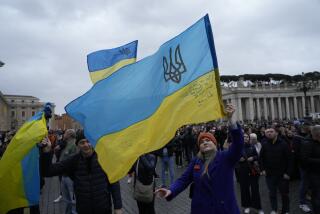Virtually a Political Miracle
- Share via
Among all the astonishing sights in this astonishing year, this was perhaps the most extraordinary: There in Rome on Friday was Mikhail S. Gorbachev, Lenin’s heir, reverential but smiling, stepping forward to take the hand of John Paul II, Peter’s successor, while a red-dressed Raisa and beaming princes of the church looked on. Then the most important Communist in the world, baptized Mikhail Sergeivich by the Russian Orthodox Church, and the Supreme Pontiff of the Roman Catholic Church, christened Karol Wojtyla in Kracow, Poland, 69 years ago, went into the papal library for a private chat. And when they emerged a little more than an hour later, the world had changed. For what the Soviet leader characterized as a meeting between fellow Slavs produced not just good feeling, but agreement between two of the 20th Century’s most unyielding antagonists: communism and the Catholic Chuch.
The Pope, as Gorbachev had hoped, conferred a Petrine seal of approval on perestroika. “The Holy See follows with great interest the process of renewal which you have set in motion in the Soviet Union,” John Paul said. “It wishes you success and declares itself ready to support every initiative that will protect and integrate the rights and duties of individuals and peoples, so that peace may be ensured in Europe and in the world.” Whether the Pontiff also provided hoped-for assurances to the Kremlin that Catholic clergy will try to restrain their nationalist enthusiasms in the Baltic republics and the Ukraine remains to be discovered.
For his part, Gorbachev, who Thursday expressed his desire to enlist organized religion’s moral authority in his reform movement, promised a new statute on liberty of conscience. “All (believers) have a right to satisfy their spiritual needs,” said the leader of the world’s first officially atheistic state. “Shortly, a law on the freedom of conscience will be adopted in our country . . . Respect for the people’s national, spiritual and cultural identity is an indispensable condition for a steady international environment, which Europe and the world now need to cross the historic watershed and attain a new period of peace.”
The latter reference clearly was intended to cover the sensitive question of the Ukrainian Catholic Church, which was proscribed by Josef Stalin after the Second World War, and has been persecuted ever since. In fact, at virtually the moment Gorbachev entered the Vatican, Soviet officials in the Ukraine announced what amounted to de facto legalization of the church there.
This, coupled with the announcements that diplomatic relations would be resumed between the Kremlin and the Holy See and that the Pope had himself been invited to the Soviet Union, were singular triumphs in the patient career of a man who passed all but unnoticed Friday as the Soviet leader and Catholic Pope shared the spotlight. Cardinal Agostino Casaroli, now papal secretary of state, was a young monsignor in 1963, when Pope John XXIII asked him to reopen the Vatican’s contacts with the communist world. Since then, he has doggedly pursued an often controversial policy of what he called “small steps.”
“A church deprived of freedom and forced continually to compromise,” he once said to his critics, “is better than no church at all.” On the eve of his great achievement, Casaroli told a reporter, “We always realized that if the Holy See had an ace up its sleeve it was the ability of Catholics in these places to hold on to their faith, even though some of them suffered imprisonment and death. Now one can see the spring after a long winter.”
One also can see, at long last, an answer to Stalin’s notorious taunt: “How many divisions has the Pope?” Apparently, just as many as he needed.
More to Read
Sign up for Essential California
The most important California stories and recommendations in your inbox every morning.
You may occasionally receive promotional content from the Los Angeles Times.










